Cristiano Capone
Neuromorphic dreaming: A pathway to efficient learning in artificial agents
May 24, 2024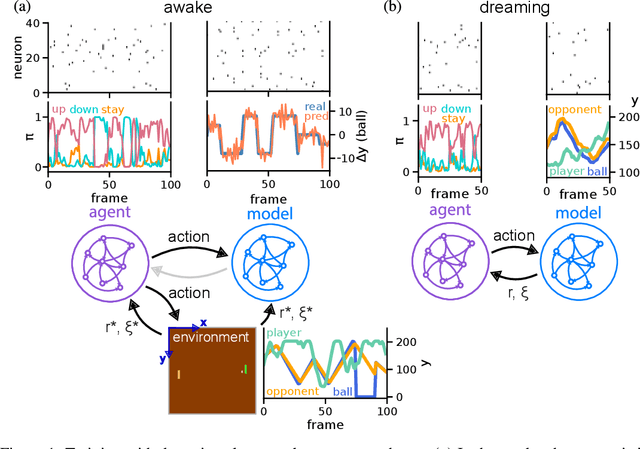
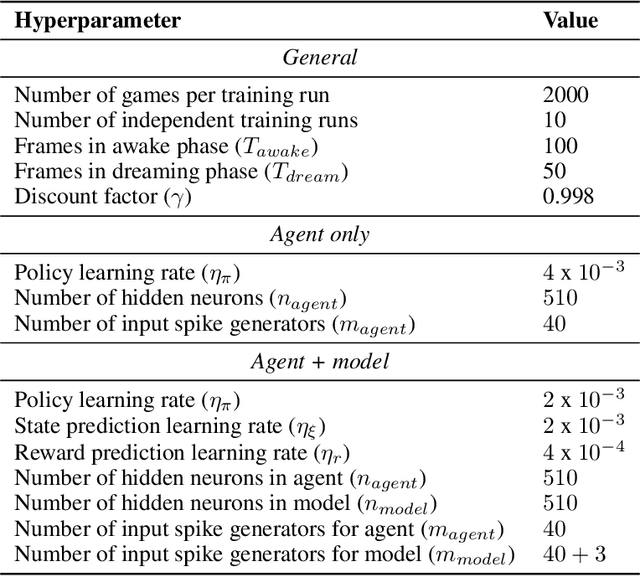

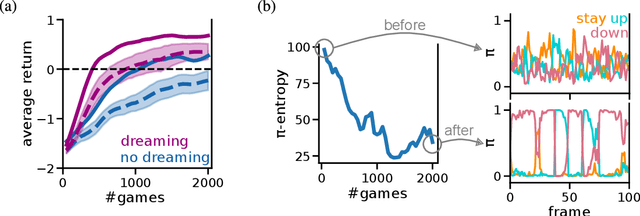
Abstract:Achieving energy efficiency in learning is a key challenge for artificial intelligence (AI) computing platforms. Biological systems demonstrate remarkable abilities to learn complex skills quickly and efficiently. Inspired by this, we present a hardware implementation of model-based reinforcement learning (MBRL) using spiking neural networks (SNNs) on mixed-signal analog/digital neuromorphic hardware. This approach leverages the energy efficiency of mixed-signal neuromorphic chips while achieving high sample efficiency through an alternation of online learning, referred to as the "awake" phase, and offline learning, known as the "dreaming" phase. The model proposed includes two symbiotic networks: an agent network that learns by combining real and simulated experiences, and a learned world model network that generates the simulated experiences. We validate the model by training the hardware implementation to play the Atari game Pong. We start from a baseline consisting of an agent network learning without a world model and dreaming, which successfully learns to play the game. By incorporating dreaming, the number of required real game experiences are reduced significantly compared to the baseline. The networks are implemented using a mixed-signal neuromorphic processor, with the readout layers trained using a computer in-the-loop, while the other layers remain fixed. These results pave the way toward energy-efficient neuromorphic learning systems capable of rapid learning in real world applications and use-cases.
Towards biologically plausible Dreaming and Planning
May 20, 2022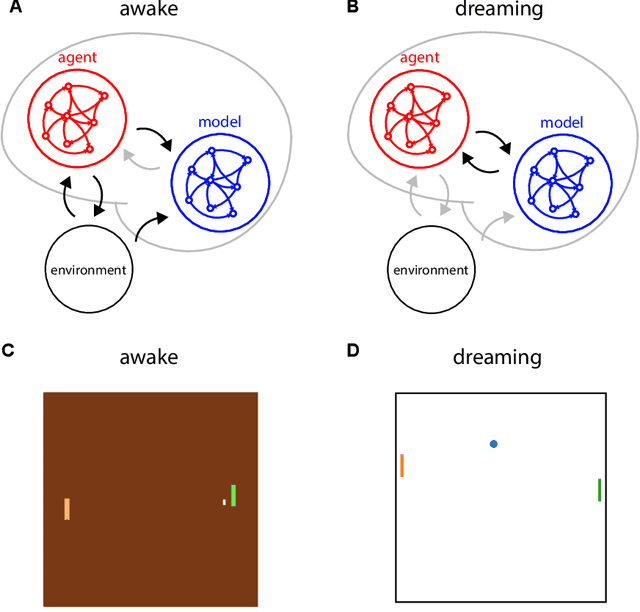
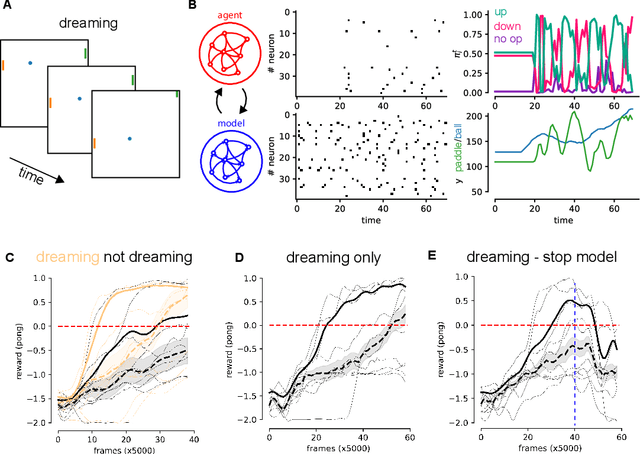
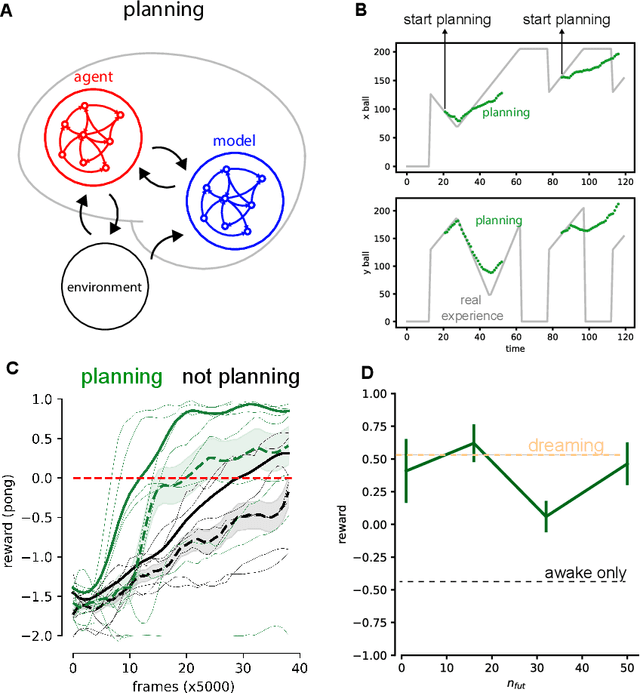
Abstract:Humans and animals can learn new skills after practicing for a few hours, while current reinforcement learning algorithms require a large amount of data to achieve good performances. Recent model-based approaches show promising results by reducing the number of necessary interactions with the environment to learn a desirable policy. However, these methods require biological implausible ingredients, such as the detailed storage of older experiences, and long periods of offline learning. The optimal way to learn and exploit word-models is still an open question. Taking inspiration from biology, we suggest that dreaming might be an efficient expedient to use an inner model. We propose a two-module (agent and model) neural network in which "dreaming" (living new experiences in a model-based simulated environment) significantly boosts learning. We also explore "planning", an online alternative to dreaming, that shows comparable performances. Importantly, our model does not require the detailed storage of experiences, and learns online the world-model. This is a key ingredient for biological plausibility and implementability (e.g., in neuromorphic hardware). Our network is composed of spiking neurons, further increasing the energetic efficiency and the plausibility of the model. To our knowledge, there are no previous works proposing biologically plausible model-based reinforcement learning in recurrent spiking networks. Our work is a step toward building efficient neuromorphic systems for autonomous robots, capable of learning new skills in real-world environments. Even when the environment is no longer accessible, the robot optimizes learning by "reasoning" in its own "mind". These approaches are of great relevance when the acquisition from the environment is slow, expensive (robotics) or unsafe (autonomous driving).
Scaling of a large-scale simulation of synchronous slow-wave and asynchronous awake-like activity of a cortical model with long-range interconnections
Feb 22, 2019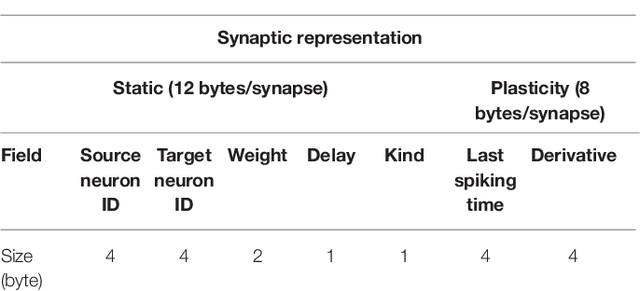
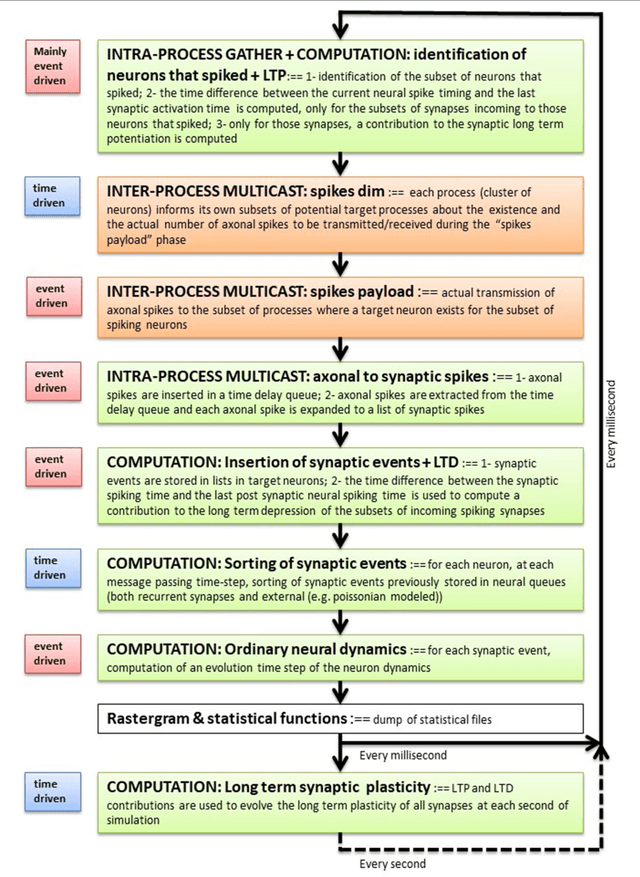
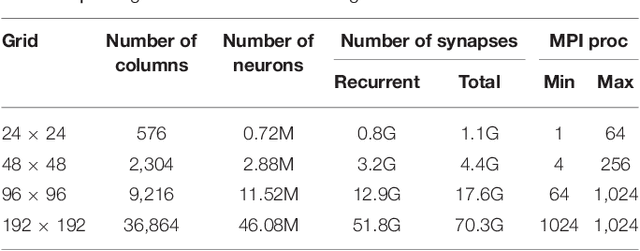
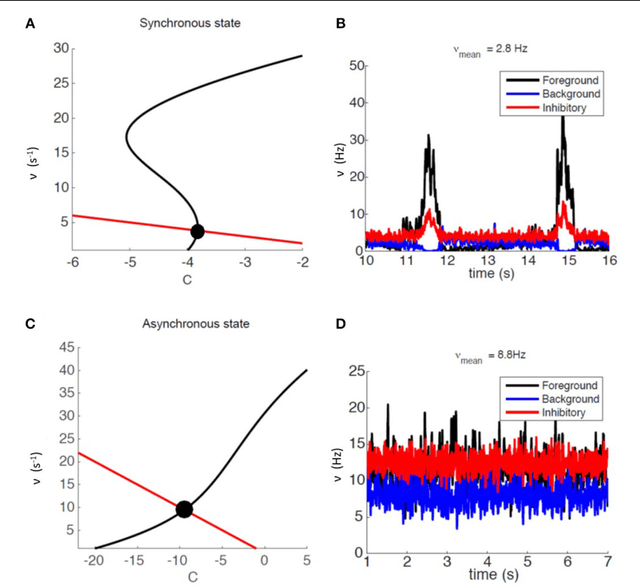
Abstract:Cortical synapse organization supports a range of dynamic states on multiple spatial and temporal scales, from synchronous slow wave activity (SWA), characteristic of deep sleep or anesthesia, to fluctuating, asynchronous activity during wakefulness (AW). Such dynamic diversity poses a challenge for producing efficient large-scale simulations that embody realistic metaphors of short- and long-range synaptic connectivity. In fact, during SWA and AW different spatial extents of the cortical tissue are active in a given timespan and at different levels, which implies a wide variety of loads of local computation and communication. A balanced evaluation of simulation performance and robustness should therefore include tests of a variety of cortical dynamic states. Here, we demonstrate performance scaling of our proprietary Distributed and Plastic Spiking Neural Networks (DPSNN) simulation engine in both SWA and AW for bidimensional grids of neural populations, which reflects the modular organization of the cortex. We explored networks up to 192x192 modules, each composed of 1250 integrate-and-fire neurons with spike-frequency adaptation, and exponentially decaying inter-modular synaptic connectivity with varying spatial decay constant. For the largest networks the total number of synapses was over 70 billion. The execution platform included up to 64 dual-socket nodes, each socket mounting 8 Intel Xeon Haswell processor cores @ 2.40GHz clock. Network initialization time, memory usage, and execution time showed good scaling performances from 1 to 1024 processes, implemented using the standard Message Passing Interface (MPI) protocol. We achieved simulation speeds of between 2.3x10^9 and 4.1x10^9 synaptic events per second for both cortical states in the explored range of inter-modular interconnections.
Real-time cortical simulations: energy and interconnect scaling on distributed systems
Dec 27, 2018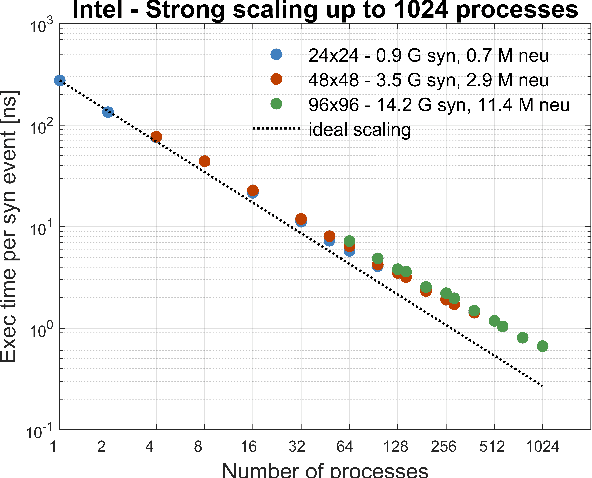
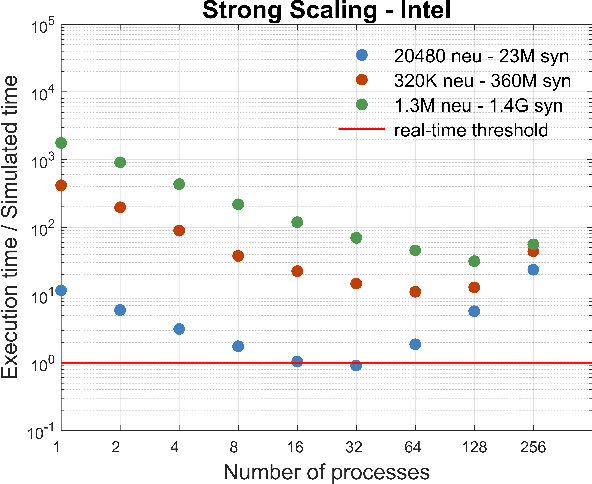
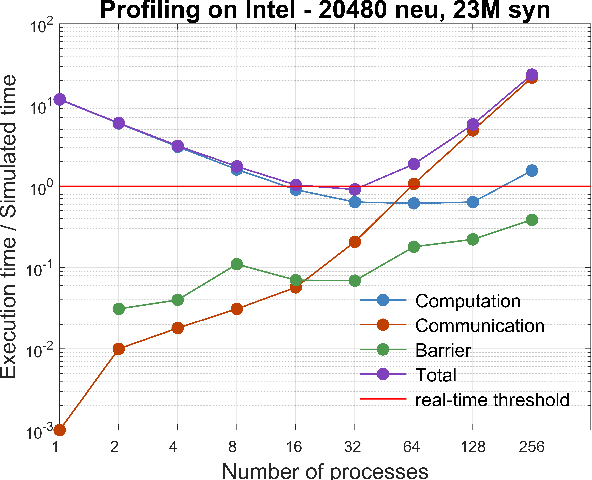
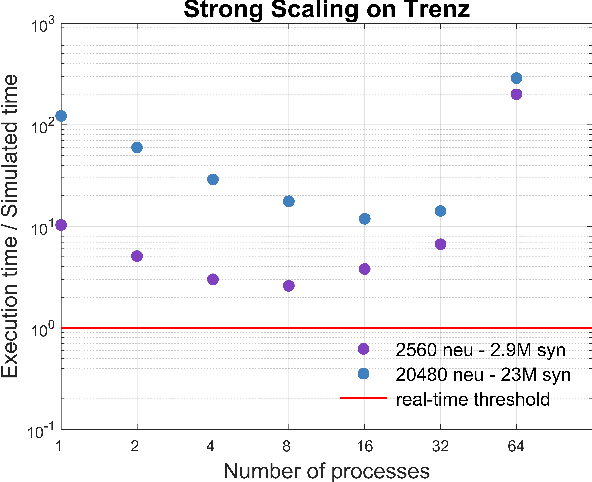
Abstract:We profile the impact of computation and inter-processor communication on the energy consumption and on the scaling of cortical simulations approaching the real-time regime on distributed computing platforms. Also, the speed and energy consumption of processor architectures typical of standard HPC and embedded platforms are compared. We demonstrate the importance of the design of low-latency interconnect for speed and energy consumption. The cost of cortical simulations is quantified using the Joule per synaptic event metric on both architectures. Reaching efficient real-time on large scale cortical simulations is of increasing relevance for both future bio-inspired artificial intelligence applications and for understanding the cognitive functions of the brain, a scientific quest that will require to embed large scale simulations into highly complex virtual or real worlds. This work stands at the crossroads between the WaveScalES experiment in the Human Brain Project (HBP), which includes the objective of large scale thalamo-cortical simulations of brain states and their transitions, and the ExaNeSt and EuroExa projects, that investigate the design of an ARM-based, low-power High Performance Computing (HPC) architecture with a dedicated interconnect scalable to million of cores; simulation of deep sleep Slow Wave Activity (SWA) and Asynchronous aWake (AW) regimes expressed by thalamo-cortical models are among their benchmarks.
Sleep-like slow oscillations induce hierarchical memory association and synaptic homeostasis in thalamo-cortical simulations
Oct 24, 2018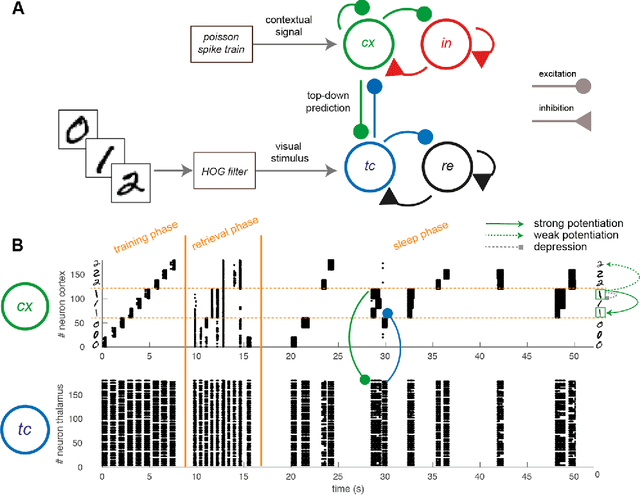
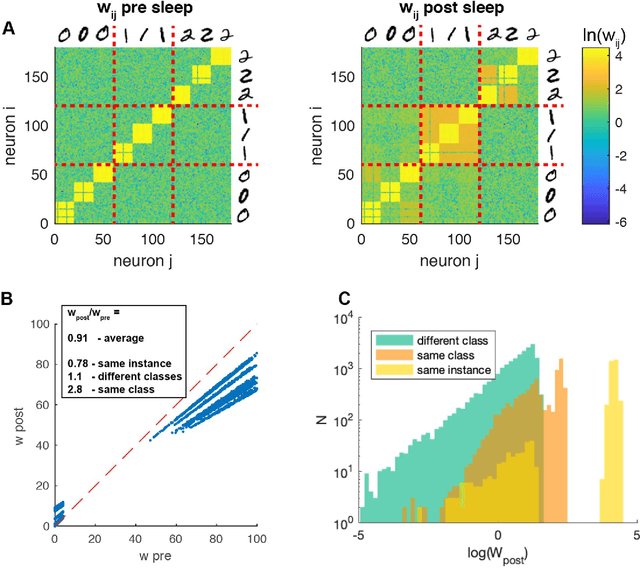

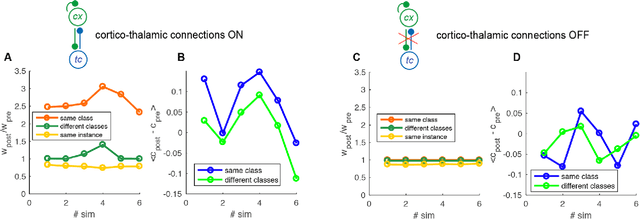
Abstract:The occurrence of sleep is widespread over the large majority of animal species, suggesting a specific evolutionary strategy. The activity displayed in such a state is known to be beneficial for cognitive functions, stabilizing memories and improving the performances in several tasks. Despite this, a theoretical and computational approach to achieve the understanding of such mechanism is still lacking. In this paper we show the effect of sleep-like activity on a simplified thalamo-cortical model which is trained to encode and retrieve images of handwritten digits. We show that, if spike-timing-dependent-plasticity (STDP) is active during sleep, the connections among groups of neurons associated to instances of the same class (digit) are enhanced, and that the internal representation is hierarchical and orthogonalized. Such effect might be beneficial to the network to obtain better performances in retrieval and classification tasks and to create hierarchies of categories in integrated representations. The model leverages on the coincidence of top-down contextual information with bottom-up sensory flow during the training phase and on the integration of top-down predictions and bottom-up pathways during deep-sleep-like slow oscillations.
 Add to Chrome
Add to Chrome Add to Firefox
Add to Firefox Add to Edge
Add to Edge